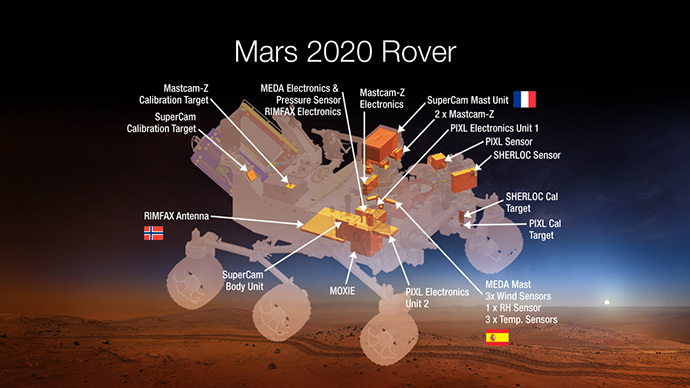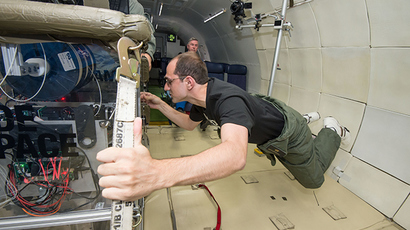NASA looks to produce oxygen on Mars with next rover

The next Mars rover is going to be home to numerous ambitious experiments, including one that will see NASA try to produce oxygen on the Red Planet.
If successful, the project could help lead the way for a sustained human presence on Mars, as well as offer astronauts an effective method for producing rocket fuel that could be used for return trips to Earth.
According to the Associated Press, the device would accompany the next rover NASA will use to explore Mars in 2021. Dubbed “MOXIE,” it wouldn’t even create one ounce of oxygen every hour, but a successful operation has big implications for future missions.
The space agency is hoping to construct a device 100 times bigger and launch it to Mars two years before it sends its own astronauts in the 2030s, so it can start producing ample amounts of oxygen before they even arrive.
"We are excited that NASA's Space Technology Program is partnered with Human Exploration and the Mars 2020 Rover Team to demonstrate our abilities to harvest the Mars atmosphere and convert its abundant carbon dioxide to pure oxygen," James Reuther, deputy associate administrator for programs for the Space Technology Mission Directorate, in a statement.
"This technology demonstration will pave the way for more affordable human missions to Mars where oxygen is needed for life support and rocket propulsion."
While oxygen is just one of the primary ingredients needed to make rocket fuel, other parts – like the hydrogen used as a propellant – can be carried to Mars from Earth or extracted from the Red Planet’s soil. If NASA can effectively make fuel on Mars instead of lugging two trips’ worth in a spaceship, it could lessen a ship’s cargo load and decrease the cost of the trip significantly.

The announcement comes just a couple of days after scientists unveiled another potentially helpful oxygen-creating device: an artificial-yet-biological leaf made from protein extracted from silk fiber. Much like a real plant, the leaf uses photosynthesis to create oxygen, and its creator is hoping NASA takes notice.
The Toys
Some of the others to make it into the lab are the super zoom,
which will top Curiosity’s abilities by being able to make
ultra-high-def terrain mappings and shoot at wavelengths
invisible to our eyes, thanks to being attached to the upgraded
Mastcam-Z.
Up next is the SuperCam, which is really a laser, designed to zap
rocks to dust and immediately analyze their chemical composition
as the vapor comes up. Although Curiosity can do the same, this
toy will be able to do it better and again, at different
wavelengths. As a result, researchers will know which rocks merit
further studying.
There is also the MEDA (the Mars Environmental Dynamics
Analyzer), that will take down readings of wind, pressure,
temperature, humidity and other atmospheric changes, along with
Mars’s dust, of which we know almost nothing.
An even more exciting tool than the souped-up cams is the new
radar, which will be able to map things underground, up to 1.5km
deep, in places where the 2020’s lasers just can’t probe.
A new X-ray device will also be onboard to map the chemical
composition and the minerals embedded in rocks, in order to
determine where microbes could have lived and if we’re likely to
see more in the vicinity.

One very important tool on the 2020 will be the organic molecule hunter, which will combine the functions of lasers and molecule analyzers, in order for there to be an overlap between the vessel’s functions – something the scientists give paramount importance to, in case of unforeseen scenarios and to double-check results.
But the most exciting of them all, according to the scientists themselves, will be the MOXIE – a special reverse fuel cell that feeds on electricity in order to produce oxygen. And if the tool works, Mars’s 96 percent carbon-dioxide atmosphere will not be a problem for us, because we’ll be producing enough oxygen to sustain whole cities.
Credit goes to MIT. As key scientist on the project and assistant director for research management at the MIT Haystack Observatory, Michael Hecht, pointed out, “Human exploration of Mars will be a seminal event for the next generation, the same way the moon landing mission was for my generation… I welcome the opportunity to move us closer to that vision.”

MOXIE’s unparalleled ability to make oxygen out of resources that aren’t native to our Earth is what has everyone anticipating great discoveries for the future.
As is explained in MIT’s press release, “in a normal fuel cell, fuel is heated together with an oxidizer — often oxygen — producing electricity. In this case, however, electricity produced by a separate machine would be combined with carbon dioxide from the Martian air to produce oxygen and carbon monoxide in a process called solid oxide electrolysis.”
And as Hecht puts it, “if we can eliminate [the need for transporting oxygen] by making the oxygen on Mars, we’re way ahead of the game."
As RT reported previously, colonizing Mars is high on NASA’s list of ambitions. The agency’s chief scientist, Dr. Ellen Stofan, said putting boots on the Red Planet would be the most effective way of scouring it for signs of life.
“Humans can actually read a landscape, go through a lot of rocks – crack them open, throw them, pick up the next one,” she said in June. “Rovers are great, they do amazing science, but it is a lot more tedious process – they go much less far than a human can cover in a day. Having humans on the surface is how I think we are going to be able to demonstrate totally conclusively that life did evolve on Mars.”















